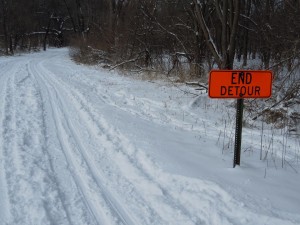
The Iowa Department of Natural Resources reported that March 2013 was the coldest March since 1975 with temperatures averaging 7.4 degrees colder than normal. The cold weather, plus frequent snow cover, kept soils frozen across the state for most of the month, thus preventing much moisture from soaking into dry Iowa soils. (photo/Cindy Hadish)
Only one small patch of snow along the fence in my yard made it through the 60-degree temperatures in Eastern Iowa and it finally felt like spring! The Iowa Department of Natural Resources reports that last month was the coldest in nearly four decades and, on a more positive note, some parts of Iowa have moved out of the drought category.
Read on for more from the DNR, issued April 4, 2013:
DES MOINES—General drought conditions in Iowa have improved over the past month and a small area of southeast Iowa is now viewed as normal ― free of drought conditions. For the fourth consecutive month, average rainfall has been slightly over normal. In March it was 0.04 above the historical normal of 2.15 inches for the month.
Shallow groundwater levels across north-central, southeast, and northeast Iowa have improved substantially over the last month. Warmer temperatures have resulted in snow melt in north-central and northeast Iowa, and groundwater levels have risen across much of the state — from 2.5 feet in Hancock County to over 9 feet in Fayette County. However, very little improvement has occurred in much of the western third of Iowa. Sioux, O’Brien, Osceola, Shelby and Crawford counties are especially hard hit.
This was the coldest March since 1975 with temperatures averaging 7.4 degrees colder than normal. The cold weather, plus frequent snow cover, kept soils frozen across the state for most of the month, thus preventing much moisture from soaking into dry Iowa soils. At month’s end, soils were mostly thawed across southern Iowa but considerable frost remains across the north.
For a more thorough review of Iowa’s water resource trends March 8 through April 3 go to http://www.iowadnr.gov/watersummaryupdate.
The report is prepared by the technical staff from the Iowa DNR, the Iowa Department of Agriculture and Land Stewardship, and the USGS, in collaboration with the Iowa Department of Homeland Security and Emergency Management Division.

No Comments Yet